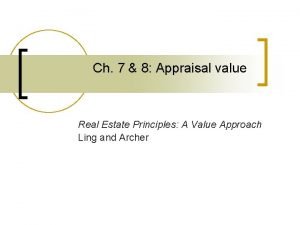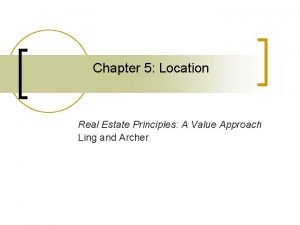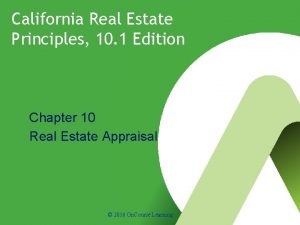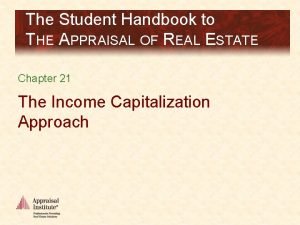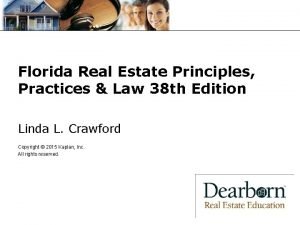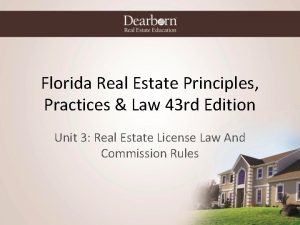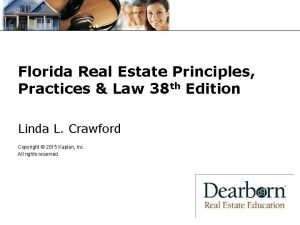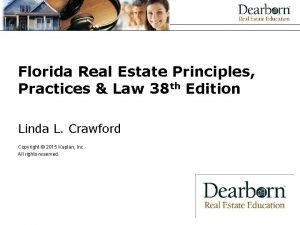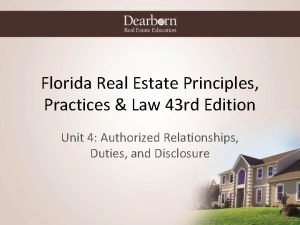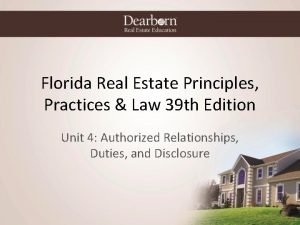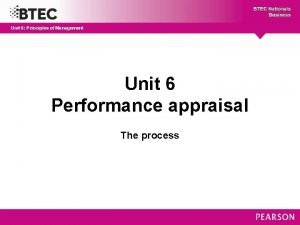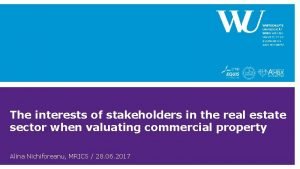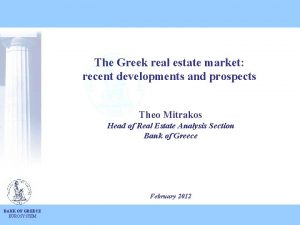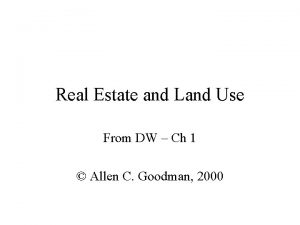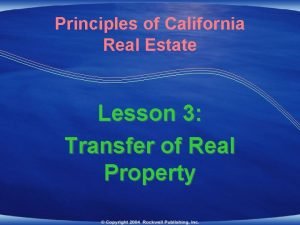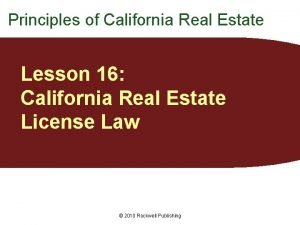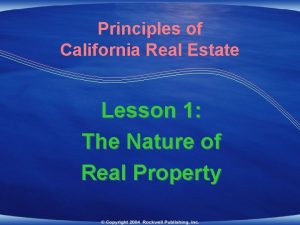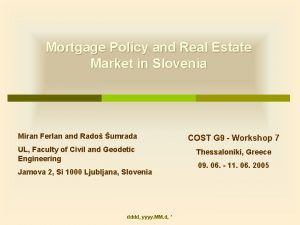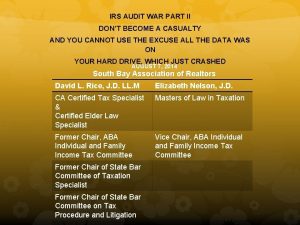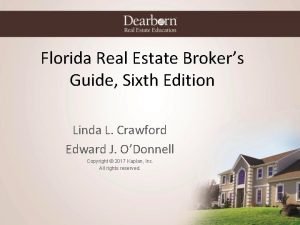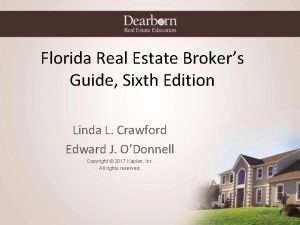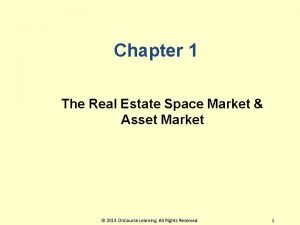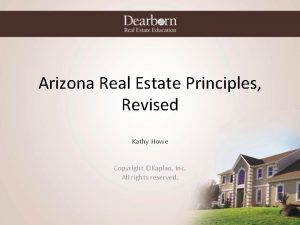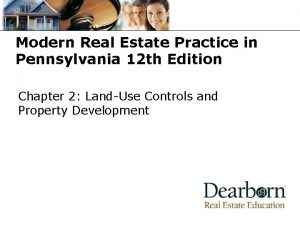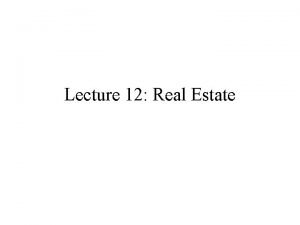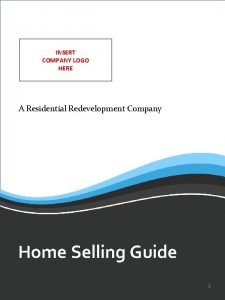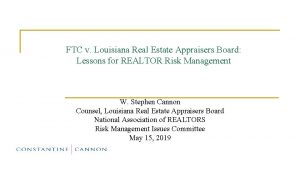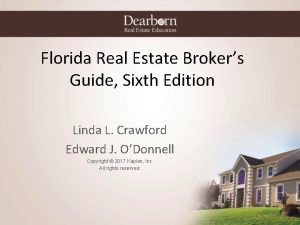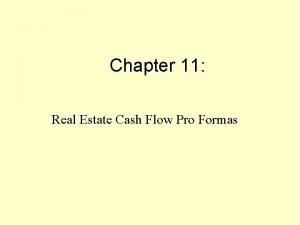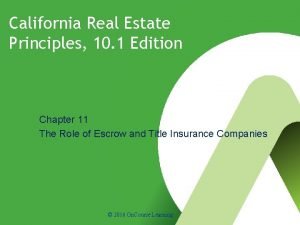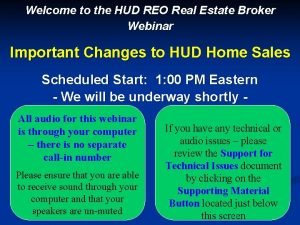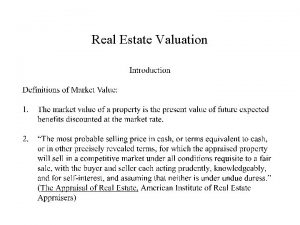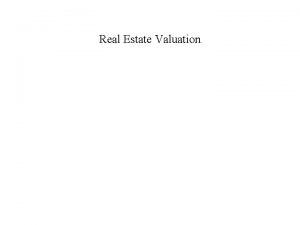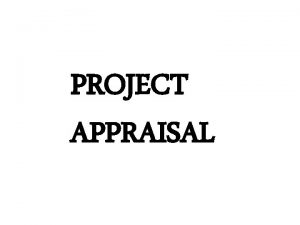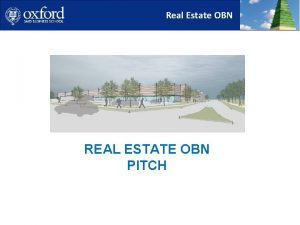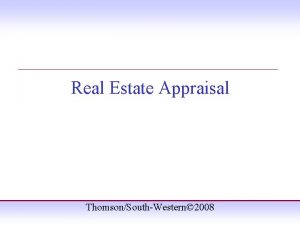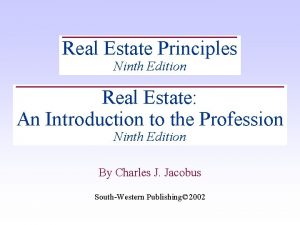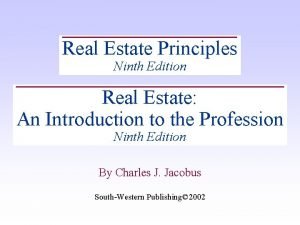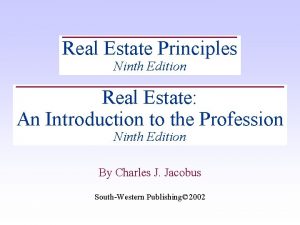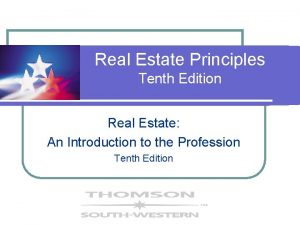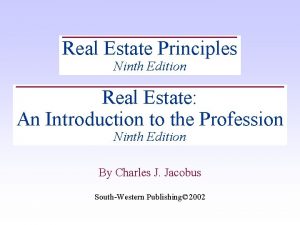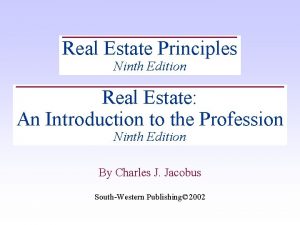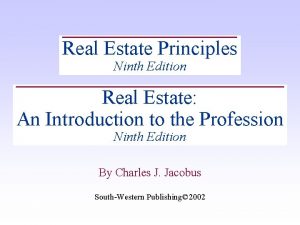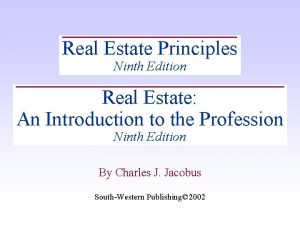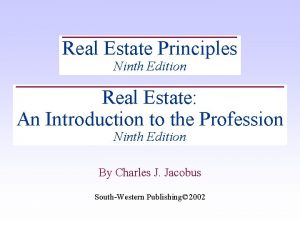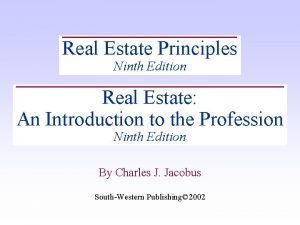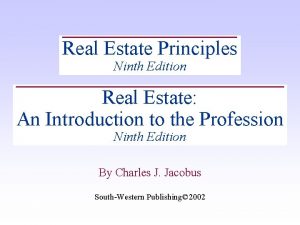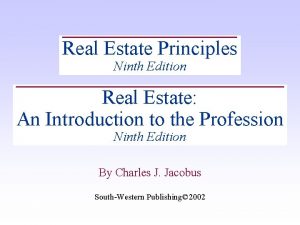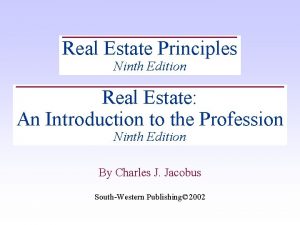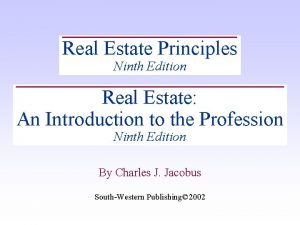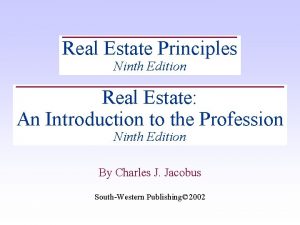Ch 7 8 Appraisal value Real Estate Principles



























































- Slides: 59

Ch. 7 & 8: Appraisal value Real Estate Principles: A Value Approach Ling and Archer

Outline n n The appraisal process Sales comparison approach Cost approach Income approach

Appraisal value = market value n n Chapters 7 & 8 focus on estimating the market value of RE, i. e. , the most probable selling price, assuming normal sale conditions. In contrast to market (appraisal) value, investment value is the value a particular investor places on a property (Chapter 19).

The appraisal report n n Chapters 7 & 8 try to arrive at an appraisal that is an unbiased written estimate of the fair market value of a property, usually referred to as the subject property, at a particular time. This process leads to an appraisal report that is the document the appraiser submits to the client and contains (1) the appraiser’s final estimate of value, (2) the data upon which the estimate is based, and (3) the calculations used to arrive at the estimate.

Uses of an appraisal report n n Applying for a mortgage. Establishing a benchmark for setting the ask price and the bid price.

USPAP n n n The Uniform Standard of Professional Appraisal Practice (USPAP), established in 1987 and maintained by the Appraisal Foundation, are currently required and followed by all states and federal regulatory agencies. USPAP imposes both ethical obligations and minimum appraisal standards that must be followed by all professional appraisers. To comply with USPAP, appraisers follow a general appraisal framework.

The appraisal process, I (Exhibit 7 -1, p. 164) n n 1. Identify the appraisal problem. The appraiser identifies (1) the property to be valued, (2) the property rights to be valued; e. g. , fee simple absolute or leasehold, (3) the type of value to be estimated; value estimates for insurance, taxation, or other purposes, (4) the date of the estimate, and (5) limitations of the analysis.

The appraisal process, II n n 2. Determine the required scope of work. The worked performed should be consistent with the expectations of typical uses of similar appraisals.

The appraisal process, III n n n 3. Collect data and describe property. Data are collected concerning the market and property-specific context of the subject property. The information often includes such items as recent transaction information, rental rates, vacancy rates, physical characteristics of the subject property and comparable properties, flood zone data, population and employment trends, and land use data.

The appraisal process, IV n n n 4. Perform data analysis. This include market analysis: supply, demand, marketability. The highest and best use of a property is defined as the use found to be (1) legally permissible, (2) physically possible, (3) financial feasible, and (4) maximally productive, i. e. , yielding the greatest net benefit to an owner. In most appraisal assignments, property is valued at its highest and best use. The appraiser usually visualizes highest and best use in two separate circumstances: (1) highest and best use of the land as though vacant, and (2) highest and best use of the property as improved.

The appraisal process, V n 5. Determine value of land.

The appraisal process, VI n n n 6. Apply 3 conventional approaches to valuation. There are 3 conventional approaches: (1) the sales comparison approach, (2) the income approach, and (3) the cost approach. Generally, all three approaches should be used in a formal appraisal. The sales comparison approach is usually the preferred approach. It is applicable to almost all one- to four-family residential properties and even to some types of incomeproducing properties where enough comparable sales are available. The income approach is the dominant approach for incomeproducing properties, e. g. , offices. The cost approach is usually the last resort when there are no comparable sales and there is no income to measure, e. g. , public auditoriums.

The appraisal process, VII n n 7. Reconciliation and a final estimate of market value. Each of the 3 approaches is applied to establish alternative indicators of market value. Reconciliation: the process in which the appraiser weighs the relative reliability of value indicators for the property being valued. Usually, more weight is given to the most applicable method and most reliable data.

The appraisal process, VIII n n n 8. The appraisal report. Report final value estimate. The content of appraisal reports must meet the requirements of one of the reporting options defined in USPAP.

Sales comparison approach n Basic Idea: ¡ n Value of RE can be determined by analyzing the sale prices of similar properties. Why? ¡ Because in a competitive market close substitutes will sell for similar prices.

The process n Exhibit 7 -3 Identify Elements of Comparison & Value Adjustment Select Comparable Sales Adjust Comparable Sale Prices w. r. t. Subject Reconcile Adjusted Sale Prices; Obtain Indicated Value

Step 1 n n 1. Identify elements of comparison and value adjustment. These elements are the relevant characteristics used to compare and adjust the property prices. Examples include location, site size, sale date, construction quality, building age, number of bath, etc. That is, those elements that have implications on the value of the property.

Step 2 n n n 2. Select comparable sales. Identify recent sales that are similar to the subject property and located in immediate neighborhood. Select commercial comparables that compete with the subject property for buyers and/or tenants. Arm’s-length transactions. Comparable sales are fairly negotiated transactions; no foreclosures. Usually need at least 3 comparable sales.

Data n The sources of market data on comparable sales include: (1) public records, e. g. , the local (county) property tax assessor’s office, (2) multiple listing service (MLS) that is usually maintained by the local board of realtors, and (3) private data services.

Step 3, I n n 3. Adjust comparable sale prices to approximate subject. 2 categories: (1) transactional adjustments, such as condition of sale, financing terms, and market conditions, (2) property adjustments, such as location, physical characteristics, legal characteristics, use, and non-realty items (personal property). Condition of sale: arm’s-length transactions are preferable. Financing terms: a favorable financing term (e. g. , low-income homebuyer programs) is often associated with a higher purchase price. Try not to use sales with special financing terms because their adjustments are difficult.

Step 3, II n n n Market conditions: historical sale prices need to be adjusted to reflect current market conditions. Location: real estate value is about location; this adjustment is rather difficult. Physical characteristics: differences in lot size, quality of structure, floor plan have implications on RE value. Legal characteristics: select sales with the same bundle of rights; the adjustments are difficult. Use: if you are asked to appraise a single-family residence and a similar house next door is currently used as a law office. Its current sale is not a comparable sale.

Step 4 n n n 4. Reconcile adjusted sale prices; obtain indicated value. The final adjusted sale prices of comparables are reconciled to the indicated value. Appraisers usually give more weights to the final adjusted sale prices of comparables that have more complete data, fewer and smaller adjustments (more similar), and more recent transactions.

Sequence of adjustments Transaction price of comparable +/- Property rights conveyed (most tricky adjustment) +/- Financing terms (low-income loan? ) +/- Conditions of sale ( a forced sale? ) +/- Expenditures immediately after purchase +/- Market conditions = Market-adjusted normal sale price +/- Location +/- Physical characteristics (lot size, structure size, etc. ) +/- Economics characteristics (tenant mix, lease terms, etc. ) +/- Use (most tricky adjustment) +/- Non-realty items = Indication of subject value

An example n n n n n We are working on an appraisal for the subject property (S). A comparable property (C 1) sold six months ago for $150, 000. The adjustments for the various elements of comparison have been calculated as follows: Location: -5 percent (i. e. , S has a worst location than C 1) Market conditions: +8 percent Physical characteristics: +$12, 500 Financing terms: -$2, 600 Conditions of sale: 0 Legal characteristics: 0 Use: 0 Nonrealty items: -$3, 000

The indicated value n n n Transaction price $150, 000 Adjustment for financing terms Minus $2, 600 Adjusted price = $147, 400 Adjustment for market conditions Plus 8% $11, 792 Adjusted price = $159, 192 Adjustment for location Minus 5% $7, 959. 60 Adjusted price = $151, 232. 40 Adjustment for physical characteristics Plus $12, 500 Adjusted price = $163, 732. 40 Adjustment for nonrealty items minus $3, 000 Indication of subject value = $160, 732

Reconciliation n Comparable C 1 yields an indication of subject value = $160, 732. Suppose that comparable C 2 yields an indication of $170, 050, and comparable C 3 yields an indication of $158, 405. One possible reconciliation is: appraisal value = $163, 062 (simple average of $160, 732, $170, 050, and $158, 405).

Cost approach Estimated reproduction cost of improvements − Estimated accrued depreciation = Depreciated cost of building improvements + Estimated value of site = Indicated value by the cost approach

Some elements n n The reproduction cost is the cost to construct the building today, replicating it in exact detail. This includes any outdated functional aspects of the building. Accrued depreciation is the actual reduction in market value of the building. It is the difference between the market value of a building and the total cost to reproduce it new. It can be attributed to (1) physical deterioration, (2) functional obsolescence, e. g. , poor room arrangement, and (3) external obsolescence, e. g. , a deterioration in the neighborhood.

Income approach n n n The use of the income approach is popular for evaluating incomegenerating properties. Commercial property owners usually expect that they will receive cash flows from their properties. That is, the perceived value is derived from incomes.

Step 1 n n n n 1. First, estimate a property’s expected periodic incomes and cash flows. The measure of operating income is the annual net operating income (NOI). The measure of before-tax cash flow is property-beforetax cash flow (PBTCF). NOI is equal to expected annual rental income, net of vacancies, minus operating expenses. PBTCF = NOI � capital (improvement) expenditures. Financing costs and income taxes are not considered in the calculation of NOI and PBTCF because these parameters are individual-specific. Recall that appraisal is about estimating market value, not investment value.

Step 2 n n n 2. Second, convert the income estimates (possibly along with cash flow estimates as well) into a market value estimate. This converting process is called income capitalization. Two categories of income capitalization methods: (1) direct capitalization, and (2) discounted cash flow (DCF) method.

Principles for estimating NOI & PBTCF n n Evaluate all income and expense items in terms of current market conditions. Take the experience of similar properties in the market into consideration. Take the historical experience of the subject property into consideration. Appraisers’ income and expense estimates need to be in line with current market rents, average vacancy and collection losses, and normal operating and capital expenses for this type of property in this location and market.

An example n n n Centre Point office building has 9 office suites. The contract rents for 6 suites are at $1, 800 per month and for the other 3 suites are at $1, 400 per month. We first want to estimate the NOI for the next year.

NOI & PBTCF computation PGI Potential gross income – VC Vacancy & collection loss + MI Miscellaneous income = EGI Effective gross income – OE Operating expenses = NOI Net operating income – CAPX Capital expenditures = PBTCF Property-before-tax cash flow

Alternative definition of NOI Note that in some textbooks, the definition of NOI differ from the one we adopt it here. In those versions of NOI computation, CAPX is subtracted to arrive at NOI. PGI Potential gross income – VC Vacancy & collection loss + MI Miscellaneous income = EGI Effective gross income – OE Operating expenses – CAPX Capital expenditures = NOI (PBTCF) Net Operating Income n

Potential gross income (PGI) n n Potential gross income (PGI) = 6 × $1, 800 × 12 months + 3 × $1, 400 × 12 months = $180, 000. This estimate of PGI is based on contract rents. Contract rents may be different from market rents. Appraisers may want to make an adjustment to modify the PGI estimate based on market rents. Suppose that there is no need for the adjustment for Centre Point.

Effective gross income (EGI) n n Suppose that vacancy and collection losses are 10% of potential gross income. The property has no miscellaneous income, e. g. , garage rentals, parking fees, vending machines, etc. Effective gross income (EGI) = PGI – vacancy and collection losses + miscellaneous income = $180, 000 – ($180, 000 × 10%) + 0 = $162, 000.

Average vacancy rate n n n In the past few years, the US average vacancy rate is about: Office 15% (Manhattan 9%). Industrial 9%. Retail 10%. Multifamily 4%.

Some definitions n n Operating expenses: the ordinary and necessary expenditures incurred during the year (including incidental repairs) that do not materially add value, but keep the property operating and competitive in its market. Capital expenditures: replacements and alterations to a building or improvement that materially prolong its life and increase its value, along with leasing costs such as leasing commissions to brokers.

NOI n n Suppose that operating expense, e. g. , property taxes, insurance, utilities, garbage removal, maintenance, repairs, supplies, and property management, is 40% of EGI each year. Suppose that capital expenditure, e. g. , roof replacements, additions, floor coverings, kitchen equipment, air-conditioning, electrical fixtures, parking surfaces, and leasing commissions to brokers, is 5% of EGI each year. NOI 1 = EGI – operating expenses = $162, 000 – ($162, 000 × 40%) = $97, 200. PBTCF 1 = NOI 1 – capital expenditures = $97, 200 – ($162, 000 × 5%) = 89, 100.

Direct capitalization on NOI 1 n n NOI 1 = $97, 200. Direct capitalization is the process of estimating a property’s market value by dividing the next calendar year’s NOI by a current capitalization (cap) rate, R 0. V 0 = NOI 1 / R 0. (Current) cap rate R 0 is also called the overall cap rate or the going-in cap rate.

Cap rate n n n Cap rate is not an overall measure of return because its use ignores the most of future (t = 2, 3, 4, …. ) cash flows from operations. (Current) cap rate is analogous to the dividend yield on a common stock. Not a discount rate; it is a price ratio.

Estimating going-in cap rate n n n 2 methods. (1) Abstracting cap rates from comparables’ cap rates, i. e. , using the average cap rate of comparables. (2) Required going-in cap rate survey numbers. The Situs Real Estate Research Corporation (RERC) regularly surveys the cap rate expectations of institutional investors.

Method 1: Abstracting cap rate from comparables: an extreme low cap rate n n According to IPG/CRENews (2006), Taconic and NY Common's sale of 450 Park should fetch $1, 500 per square foot ($510 million), which would set a new Gotham record…. The office is located at the northern tip of "Wall Street North", at 57 th and Park, where rents continue to rise above the $100 psf mark. 2006 NOI totaled $13. 7 million, yielding a 2. 7% cap rate (!!!) at $510 million, excluding closing costs. This process is repeated for a few other comparables to arrived at a (weighted? ) average of abstracted cap rates. Then use the average as the cap rate for direct capitalization computation. Why is the cap rate so low? (4. 68% for T-bills in 2006)

Mehtod 2: Cap rate survey, US, 2014 n n n n Office CBD class A: 5. 50% Office CBD class B: 6. 91% Office CBD class C: 8. 85% Hotel CBD full service: 7. 50% Hotel CBD economy: 8. 69% Hotel suburban full service: 8. 14% Hotel suburban economy: 9. 60%

Direct capitalization result n

IRR n n Suppose that the Centre Point is bought at $980, 000, NOI 1 (you can think of this as dividends) = $97, 200, and the property is expected to increase in value to $1, 000 by the end of year 1. The expected total rate of return, y 0, or, equivalently, the expected IRR is: y 0 = [dividends + (V 1 – V 0)] / V 0 = NOI 1 / V 0 + (V 1 – V 0) / V 0 ≡ R 0 + g. y 0 = 0. 1196 = [$97, 200 + ($1, 000 - $980, 000)] / $980, 000 = 0. 0992 + 0. 0204.

Expected return on RE n n y 0 = R 0 + g. Property return has two components: (1) incomes/dividends, i. e. , cash generating power, and (2) appreciation (depreciation). Implication: with required return (yield) constant, more appreciation implies lower cap rate. As discussed in Chapter 1, required return (yield), i. e. , opportunity cost, is determined in a financially integrated capital market (competing with stocks, bonds, etc. )

Office’s g = 7. 3% - 5. 4% = 1. 9%

Causality n n n Note that risk drives return in equilibrium, regardless of whether the asset is a property or a stock. That is, y 0 is determined in the capital market. The causality goes from y 0 to R 0, not the other way around. In other words, “R 0 + g = y 0. ”

Another way to look at y 0 n n n The expected/required IRR is higher than the 10 -year T-note yield by a spread (risk premium) to compensate for the investment risk RE investors need to bear. This spread can be estimated or forecasted and added to the current 10 -year T-note yield to come up y 0. Note that the spread trends down during a bull market and trends up during a bear market.


Discount cash flow analysis n n n We have studied the 1 st method of income capitalization: direct capitalization on NOI 1. We now look at the 2 nd method: DCF. For this method, we need NOI & PBTCF estimates for a longer period of time.

The nature of NOI & PBTCF n n n 1. Recall NOI and PBTCF are before debt service. 2. Thus, NOI (PBTCF) is an income (cash flow) measure to the property, not to the owner. They are unlevered measures. 3. Recall that PBTCF is before tax. (Note that for stock valuation, we always use after-tax cash flows, either to the firm or to the equity). 4. We thus need to pair the DCF of PBTCFs with a discount rate that is also unlevered and pre-tax. 5. This discount rate is the opportunity cost: required IRR, y 0. There is no analog of y 0 in stock valuation; that is, y 0 is not the WACC (Note WACC is a levered discount rate), nor the cost of equity (note that the cost of equity is an unlevered discount rate).

Pro forma n n n Suppose that the holding period is 5 years. A pro forma analysis gives us the NOI estimates for the next 6 years: $97, 200, $98, 900, $100, 126, $102, 382, $104, 884, and $106, 000. A pro forma analysis gives us the PBTCF estimates for the next 5 years: $89, 100, $91, 773, $94, 526, $97, 362, and $100, 283. The going-out cap rate, R 5, is 10. 00%. V 5 = NOI 6 / R 5 = $106, 000 / 0. 10000 = $1, 060, 000.

DCF result n n The expected selling expenses are $58, 300. Suppose that 5 -year T-note yield is 4. 75%. Risk premium for a small-scale office investment, such as Centre Point, is 7%. Thus, y 0 is 11. 75%; that is, the (before-tax) discount rate for PBTCF’s is 11. 75%. CF 5 = $1, 060, 000 - $58, 300 + $100, 283 = $1, 101, 983. V 0 = $89, 100 / (1+ 0. 1175) + $91, 773 / (1+ 0. 1175)2 + $94, 526 / (1+ 0. 1175)3 + $97, 362 / (1+ 0. 1175)4 + $1, 101, 983 / (1+ 0. 1175)5 = $946, 085.

Final reconciliation n n A final reconciliation between $980, 000 (direct capitalization) and $946, 085 (DCF) is then reached. Suppose that the appraiser has more confidence on the DCF estimate, and decides the indicated value to be $950, 000.

Risk of CF stability n n Appraisers recently slashed the value of the University Mall — from $116. 3 million to $51. 4 million. University Mall appears to be in "fine shape" to anyone walking through it (very low vacancy rate). "What's happening in the background is leases that used to be five and 10 years are now oneyear renewals …There's no guarantee of an income stream going forward. ” 01/26/2016, Burlington Free Press.

Individual assignment n n n Subject property for Spring 2018: Unit #2302 in Four Paddle Note that the subject property changes every time I teach this course; You need to work on the subject property that I hand out in the class. Please compute its appraisal value based on the sales comparison approach with 3 comparibles.
 Income approach appraisal
Income approach appraisal Rent real estate principles a value approach
Rent real estate principles a value approach Rent real estate principles a value approach
Rent real estate principles a value approach The student handbook to the appraisal of real estate
The student handbook to the appraisal of real estate Real homes real estate
Real homes real estate Florida real estate principles practices & law
Florida real estate principles practices & law Involuntary inactive real estate license florida
Involuntary inactive real estate license florida Florida real estate principles practices
Florida real estate principles practices Florida real estate principles practices & law
Florida real estate principles practices & law Florida real estate principles practices
Florida real estate principles practices Florida real estate principles practices
Florida real estate principles practices Value creation value delivery value capture
Value creation value delivery value capture Principles of performance appraisal
Principles of performance appraisal Realtor elevator pitch example
Realtor elevator pitch example What is a mofir
What is a mofir Real estate stakeholders
Real estate stakeholders Greek real estate market
Greek real estate market Sandy miller real estate
Sandy miller real estate Define littoral rights
Define littoral rights What are the 4 types of real estate
What are the 4 types of real estate Fundamentals of analyzing real estate investments
Fundamentals of analyzing real estate investments Strategicerp-real estate erp software
Strategicerp-real estate erp software 4 quadrant model economics
4 quadrant model economics Involuntary alienation in real estate
Involuntary alienation in real estate Blind ad real estate
Blind ad real estate Emblements real estate
Emblements real estate Panama real estate law
Panama real estate law Encumbered real estate
Encumbered real estate Industrial sites meaning
Industrial sites meaning Irs audit real estate professional
Irs audit real estate professional Real property definition
Real property definition Florida real estate broker's guide
Florida real estate broker's guide Florida real estate broker's guide 6th edition
Florida real estate broker's guide 6th edition What is space market in real estate
What is space market in real estate Erp for real estate developers
Erp for real estate developers Arizona real estate law book
Arizona real estate law book Millionaire real estate investor worksheets
Millionaire real estate investor worksheets Buyers packet real estate
Buyers packet real estate Colliers turley martin tucker
Colliers turley martin tucker Real estate information management
Real estate information management Urban economics and real estate markets
Urban economics and real estate markets Multi level marketing real estate
Multi level marketing real estate Modern real estate practice in pennsylvania 14th edition
Modern real estate practice in pennsylvania 14th edition Modern real estate practice in illinois
Modern real estate practice in illinois Real estate lecture
Real estate lecture Thanandpaul
Thanandpaul La real estate appraisers board
La real estate appraisers board Free real estate presentation templates
Free real estate presentation templates Florida real estate broker's guide
Florida real estate broker's guide Denver real estate investment association
Denver real estate investment association Property development proposal presentation
Property development proposal presentation Real estate investment pro forma
Real estate investment pro forma Easton v strassburger
Easton v strassburger Closing statements real estate
Closing statements real estate Real estate market bhubaneswar
Real estate market bhubaneswar Npn real estate
Npn real estate What does naid stand for in real estate
What does naid stand for in real estate Unlimited funding
Unlimited funding Seizen real estate
Seizen real estate Osbe meaning real estate
Osbe meaning real estate
